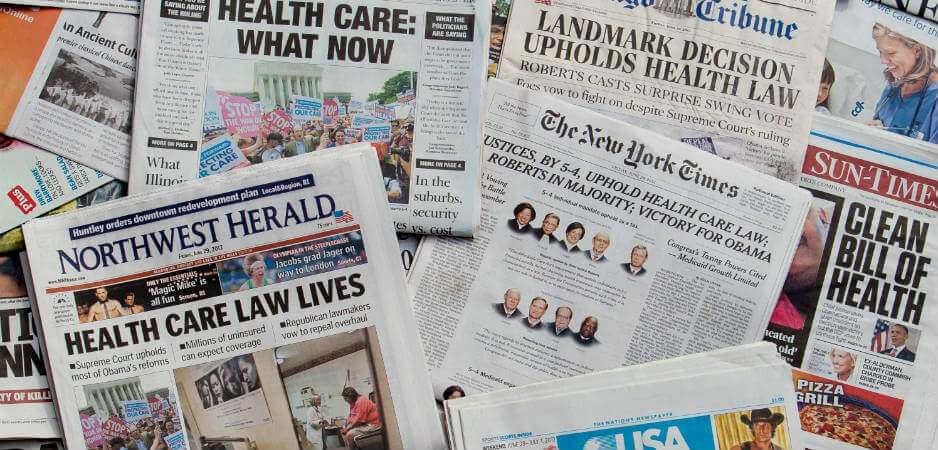The popularity of Breitbart among conservative voters is an outcome of a long-term right-wing campaign against the progressive media.
The 2016 presidential campaign was arguably the most divisive and polarized in modern American history. The election of a demagogue like Donald Trump to the White House not only exposed deep-rooted racial fault lines that continue to persist in American society, but also shed light on the economic resentment and cynicism that have been simmering in many parts of rural and suburban America.
Trump ran a campaign that was filled with hateful and xenophobic rhetoric that will most likely have far-reaching consequences on the larger public discourse in the United States. At the receiving end of his spiteful rhetoric were not only immigrants and minorities, but also journalists and the mainstream media. His constant branding of media as “biased,” “dishonest,” “rigged” and “enemies of American people” reinforced the perception of “liberal media bias” among Republican voters, and created an opportunity for the mainstreaming of ultra-conservative media outlets that were hitherto considered fringe.
Prominent among them is Breitbart News Network, a self-proclaimed platform for white nationalists and neo-Nazis. Its chairman, Steve Bannon, who was handpicked by Trump to head his presidential campaign and was later appointed the White House chief strategist, is now perhaps one of the most powerful people in the country.
The mainstreaming of ultra-conservative and propagandist outlets like Breitbart is ironic because for years the US had prided itself as the global champion for the rights of journalists and positioned itself as the harbinger of professional values in the field. These values have come to be known as Anglo-American model of journalism and has influenced many media systems around the world. The parallel rise of Trump and Breitbart poses a great challenge to this model.
History of Partisan Media in the US
The roots of partisan press in America go back to the 18th century. In fact, the period between the 1780s and 1830s in US history is known as “party press era,” because newspapers back then received patronage from political parties in the form of subsidies and government printing contracts. This era began in 1783, after the end of the American Revolution when the political systems were still nascent and continued all the way until the rise of the penny press in the 1830s.
During this period, editors and reporters shaped news and editorial content for partisan purposes and even worked part-time for state legislators and US congressmen. Some of them served as spokesmen for political parties. Journalists unabashedly adopted partisan views such as Federalist or Anti-Federalist, Whig or Democrat, Republican or Democrat.
Newspapers were filled with vituperative commentary, vindictive stories and propaganda to sway public opinion in favor of the political party they were affiliated to. Politicians such as Alexander Hamilton, who used and supported the Gazette of the United States, and Thomas Jefferson, an anti-federalist who supported the National Gazette, exchanged verbal arrows using their respective publications.
The first half of 19th century brought drastic changes in lifestyle, technology and communication systems in the US, which saw increased political participation by the working and middle classes, higher literacy rates and rapid urbanization. These socioeconomic changes led to the rise in demand for newspapers, which in turn led to the production of penny press: cheap newspapers that not only served the male political interests, but also reported on the wider world.
Instead of depending on political parties for revenue, the penny press focused on targeting new audiences and avenues for advertisements, while politicians decreased their financial support to the press and sought other means to reach their voters. Thus, changes in press-party relations in the middle of the 19th century redefined news and gave rise to a new era of objective journalism.
In the ensuing years, American journalism witnessed the emergence of a new occupational identity and development of professional ethics thanks to journalists who sought to make their profession more respectable. In the early 20th century, journalistic professionalization was institutionalized with the establishment of journalism schools across the US, where future reporters were trained in professional values in addition to the skills required to perform their job.
Mass Press
Buoyed by technological innovations such as radio, television and an ever-expanding domestic consumer market, mass press developed and spread across the US in the mid-20th century. Development of technological infrastructure and the consumer market led to the establishment of large advertising agencies and multinational media organizations that saw an opportunity in developing countries for the expansion of their business.
Countries that lagged behind in the development of media systems adopted and absorbed these technologies. In addition to media equipment and investment, much of the developing world imported values of practice that were in vogue in American newsrooms—the notion of objectivity in reporting, fairness, impartiality and balanced reporting, and ethics of newsgathering. At the same time, the high-minded purpose of journalism permeated into the American news consumers’ psyche by the middle of 20th century.
Now-standard reporting and interviewing techniques were also first invented and developed by American journalists. US-based news agencies such as Associated Press played a vital role in exporting and disseminating some of these conventions, professional ethics and normative values overseas. Since skilled personnel were required to produce content for mass communication industries to sustain, Western media organizations mostly based in the US offered formal training to non-Western journalists and broadcasters.
When other national media plunged into crisis, as in the former communist countries, American ethics of objectivity were proposed as a model to emulate. Thus, Anglo-American news values influenced and shaped journalistic practices in many parts of the world.
Conservative Charge of Liberal Bias
Even as American newsroom conventions and journalistic values were shaping global news reporting practices, conservative leaders and politicians were making investment in think-tanks and journalistic institutions in the United States as a means of moving public debate to the right. In the late 1940s and early 1950s, conservative magazines such as National Review and Human Events were launched. These became the lifeblood of modern conservatism in the postwar period. During the Civil Rights era in the 1960s, Republicans actively began building a conservative network that included setting up universities, advocacy organizations, journals and media outlets. Many Republicans believed that such networks were crucial in order to win the “war of ideas.”
At the same time, mainstream media’s negative coverage of politicians such as Barry Goldwater and President Richard Nixon increased the right-wing critique of news media. For several years, conservative media personalities such as Rush Limbaugh, Glenn Beck and Sean Hannity accused the press of “liberal bias,” which seems to have struck a chord with their core constituents. This is evident from the findings of a study conducted in the 1990s in which over two-fifths (43%) of randomly sampled respondents claimed that news media exhibited a liberal bias in presidential election coverage.
Further, the percentage of the public responding that press treatment of the Republican candidate was unfair increased 22% during the 1992 campaign, and 9% during the 1996 presidential elections. The launch of right-leaning Fox News Channel by Rupert Murdoch in 1996 cemented the notion of liberal bias among Republican voters, leading to a gradual decline of their trust in news media. According to a Gallup poll, Americans’ confidence in media has eroded from a high of 55% in 1998 to 32% in 2016. More significantly, only 14% of Republicans said they trust US media as opposed to 51% Democrats.
The conservative war on news media continues to date. The Trump administration is currently considering privatizing the Corporation for Public Broadcasting (CPB), which provides funding for the National Public Radio (NPR) and Public Broadcasting Service (PBS). During the presidential campaign, Trump severely criticized the establishment media of biased reporting and called news reporters “the lowest form of life.” He has threatened to sue The New York Times and proposed to change America’s libel laws if elected president. At his rallies, his supporters frequently booed and heckled journalists. His attacks on news organizations were so intense that the Committee to Protect Journalists (CPJ) had to intervene and pass a resolution declaring Trump “an unprecedented threat to rights of journalists.”
In fact, a Gallup poll speculated that Trump’s aggressive anti-media rhetoric could be one of the plausible reasons why Republicans think so poorly of the media. The popularity of Breitbart among conservative voters is, in many ways, an outcome of this long-term campaign of the right-wing ecosystem against the progressive media.
Mainstreaming Breitbart
Diminishing public trust in mainstream media, particularly among conservative voters, and the emergence of new media technologies provided a fertile ground for the proliferation of far-right media portals. Prominent among them include Drudge Report, VDare, The Gateway Pundit, Townhall, Daily Caller, Infowars and Breitbart News Network. While each of them play a key role in promoting the ideas on the far-right, Breitbart is associated with white ethno-nationalist groups, which were until recently considered fringe elements.
According to a Gallup poll, Americans’ confidence in media has eroded from a high of 55% in 1998 to 32% in 2016. More significantly, only 14% of Republicans said they trust US media as opposed to 51% Democrats.
With access to President Trump’s inner circle, Breitbart has grown from being an outlier to a powerful political player in a short span of time. Established by Andrew Breitbart in 2007, the website is now closely aligned with members of the “alternative-right,” or “alt-right”—a term used to describe a group of white nationalists and neo-Nazis whose goal is to preserve “white identity” and “Western civilization.” Broad swaths of the alt-right believe in race-based nationalism and white superiority. The Southern Poverty Law Center (SPLC), which monitors hate groups in the United States, found members of this group to be frequently advocating for ethnic cleansing, racial separatism, anti-Semitism and acts of violence against minority groups.
In an interview with Mother Jones in July 2016, Steve Bannon admitted that the website provided a “platform for the alt-right.” The site often features stories that attack Republican elites, foster anti-immigrant sentiment and promote political conspiracy theories. The views expressed on Breitbart are often so extreme that it has been disavowed by every other major conservative news outlet.
Yet in addition to Bannon’s role as Trump’s campaign chief, former Breitbart staffers Julia Hahn and Sebastian Gorka were hired to shape the Trump administration’s policies. In doing so, Trump mainstreamed what was until then considered extreme even by traditional Republicans.
Trump’s contribution to Breitbart’s rise is evidenced by its growing popularity on the web. ComScore, an audience-measurement platform, ranked Breitbart 27th in the general news category with about 8 million monthly visitors as of October 2014. That same month, Pew Research Center released a survey report according to which only 3% of respondents got their news from Breitbart.
However, in June 2015, when Trump announced that he would run for the president, the site was visited by 5.7% of the general news audience, and by the end of the campaign cycle in October 2016, Breitbart’s traffic was at 9% of the market, with an estimated 18 million visitors.
Enthused by Trump’s victory, Breitbart plans to launch its sites in Germany, Italy and France. It already operates in the United Kingdom, where it gives support to right-wing populist leader Nigel Farage. The move to expand to Western Europe is seen as an attempt to foment anger and anti-immigrant sentiment in that region. With the appointment of its former staffers to the White House, Trump has legitimized Breitbart and its bigotry, helping to increase its visibility.
The shift of Breitbart and other far-right media outlets from fringe to mainstream marks the return of partisan journalism that was the norm in the United States during the pre-Progressive Era. Partisan papers have now been substituted by websites such as Breitbart. As was the case in the 1830s, Breitbart’s content is filled with libelous exaggeration, biased interpretation of facts, misleading information, racist, anti-Semitic commentary and conspiracy theories—attributes that go against the professional values and journalistic ideals that defined newsroom practices in the US since the Progressive Era.
Such news outlets not only prime citizens’ underlying predispositions, but also make them more extreme and divided. In this context, political scientist Matthew Levendusky writes:
“Active and engaged like-minded viewers are pushed even further to the extremes on the specific issues discussed on partisan media. If these viewers watch regularly, and are moved across a host of issues, then this can put pressure on candidates to take more extreme positions on a number of issues … Solving problems becomes less about what is best for the country and more about what is politically and ideologically expedient. While partisan media alone do not cause these effects, they certainly exacerbate broader trends towards division, gridlock, and consensus.”
News is an important contributor to the formation of shared reality and public knowledge. Blatantly partisan outlets such as Breitbart disregard facts and spread conspiracy theories, thereby eroding common understanding from public life. This makes it difficult for lawmakers on both sides of the aisle to arrive at a consensus or find a middle ground on contentious issues.
Worse, such outlets redefine what constitutes news as they substitute facts, good judgment and accurate interpretation of data with “alternative facts,” innuendo and blatant lies.
No Easy Solutions
There are no easy solutions to fighting partisan press. Since such outlets take advantage of ethical shortcomings of mainstream news reporting, progressive media can begin with fact-checking every news report to avoid any errors. This is particularly important because even a simple misstep in news reporting would give rabble-rousers like President Trump a chance to delegitimize news media and make it into the story, rather than leave the public to focus on critical questions concerning his administration.
Additionally, to face the twin challenges of declining public trust in journalism and the meteoric rise of the far-right press, progressive media outlets must work toward rebuilding local journalism. Journalists have been accused of being “coastal media elites” who missed the breadth of support for Donald Trump in rural and suburban areas. Local journalism not only brings to light the stories of disaffected citizens largely ignored by major networks, but also helps reporters regain public trust in institutions of news reporting.
Lastly, journalists must remain committed to the canonical values and professional ethics that have been adopted by newsrooms across the world. Although a few scholars contend that dispensing with the ethics of objectivity is the only way to fight Trump, digression from professional values will only play into the hands of faux populists and give them an opportunity to further discredit media. Besides, an objective approach secures space for an honest public deliberation outside the partisan spin.
In this context, Kyle Pope, editor-in-chief of the Columbia Journalism Review, writes: “Now a new era needs to begin, a period in which reporting takes precedent over opinion, when journalists are willing to seek out and understand people with whom they may have profound personal and philosophical differences. For decades, centuries even, that has been the definition of journalism.”
Just like the journalists who broke from their parties and embraced modern ethics of objective, independent, accurate and fair reporting during the Progressive Era, it is important for contemporary journalists to deliver a collective response to counter the resurgence and mainstreaming of partisan-press. In doing so, adherence to professional values of journalism is a good starting point.
The views expressed in this article are the author’s own and do not necessarily reflect Fair Observer’s editorial policy.
Photo Credit: Allkindza
Support Fair Observer
We rely on your support for our independence, diversity and quality.
For more than 10 years, Fair Observer has been free, fair and independent. No billionaire owns us, no advertisers control us. We are a reader-supported nonprofit. Unlike many other publications, we keep our content free for readers regardless of where they live or whether they can afford to pay. We have no paywalls and no ads.
In the post-truth era of fake news, echo chambers and filter bubbles, we publish a plurality of perspectives from around the world. Anyone can publish with us, but everyone goes through a rigorous editorial process. So, you get fact-checked, well-reasoned content instead of noise.
We publish 2,500+ voices from 90+ countries. We also conduct education and training programs
on subjects ranging from digital media and journalism to writing and critical thinking. This
doesn’t come cheap. Servers, editors, trainers and web developers cost
money.
Please consider supporting us on a regular basis as a recurring donor or a
sustaining member.
Will you support FO’s journalism?
We rely on your support for our independence, diversity and quality.







